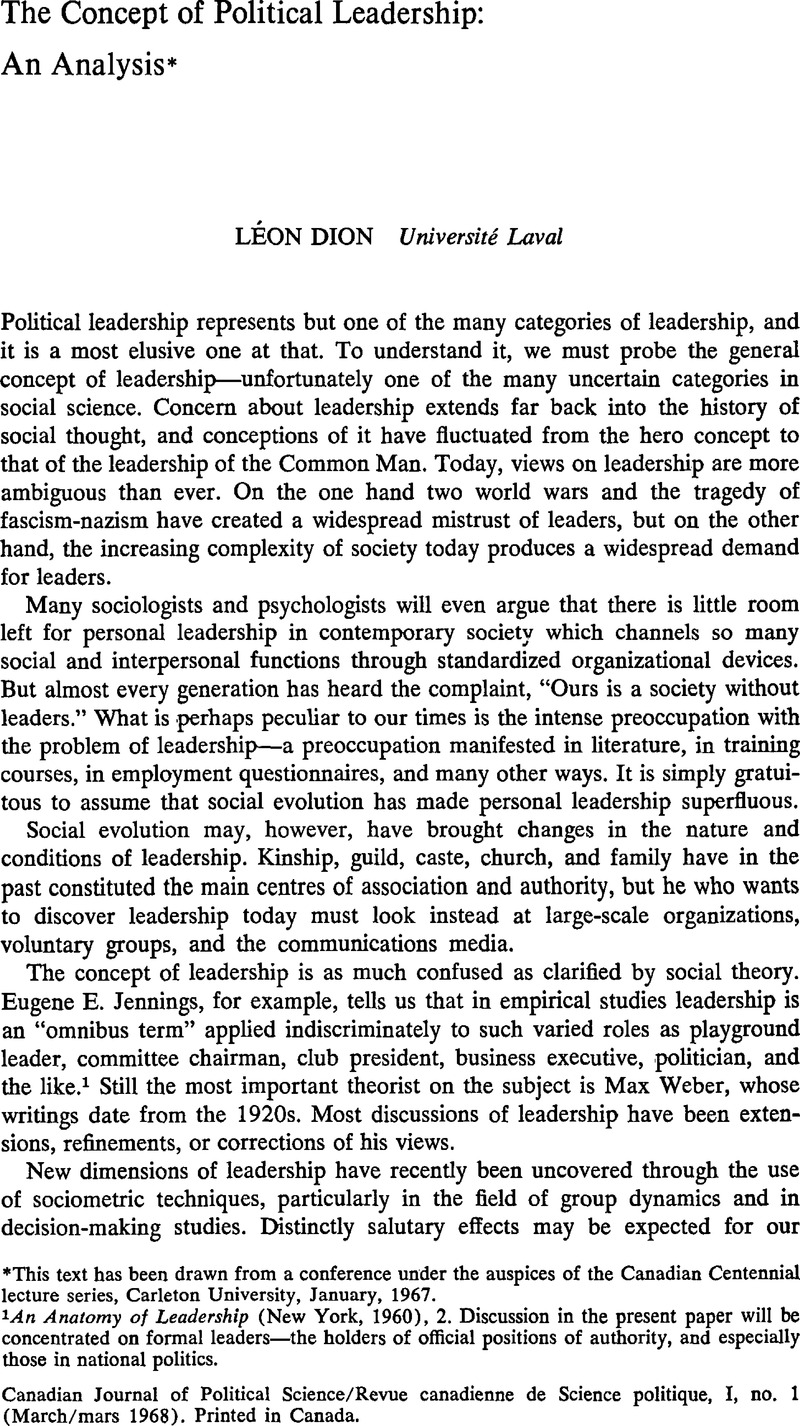Published online by Cambridge University Press: 10 November 2009

1 An Anatomy of Leadership (New York, 1960), 2. Discussion in the present paper will be concentrated on formal leaders—the holders of official positions of authority, and especially those in national politics.
2 Two studies in that direction are worth special mention: Verba, Sidney, Small Group and Political Behaviour: A Study of Leadership (Princeton, 1961)Google Scholar, and Bourricaud, François, Esquisse d”une théorie de l'autorité (Paris, 1961).Google Scholar
3 Hollander, E. P., Leaders, Groups, and Influence (New York, 1964), 1.Google Scholar
4 Gobbs, Cecil A., “The principles and traits of leadership,” Journal of Abnormal and Social Psychology, 42 (1947), 267–84.Google Scholar
5 See, for example, Stodgill, Ralph M., “Personal Factors Associated with Leadership,” Journal of General Psychology, 25 (1958).Google Scholar
6 On this aspect of Hegel's philosophy see Hook, Sidney, The Hero in History (Boston, 1943)Google Scholar, chap. IV.
7 The distinction is made by Bendix, Reinhard, Weber, Max: An Intellectual Portrait (London, 1960), 301 ffGoogle Scholar; see also Easton, David, A Systems Analysis of Political Life (New York, 1966), 301–2Google Scholar, n. 7.
8 Wolpert, Jeremiah F., “Toward a Sociology of Authority” in Gouldner, Alvin W., ed., Studies in Leadership (New York, 1950), 679–701.Google Scholar
9 Studies, for example, indicate that the correlation between intelligence and leadership is low. It seems that people tend to choose individuals just slightly more intelligent than them-selves as their leaders. Furthermore, sociometric tests show that leadership bears little relation to popularity and that it is inversely correlated with friendship. See among others, Wherry, R. I. et al., “Buddy Ratings: Popularity Contest or Leadership Criteria,” Personal Psychology, 2 (1949), 147–59.CrossRefGoogle Scholar
10 Examples of this phenomenon are found in Hitler's wearing of the Iron Cross, second class; in Stalin's high-buttoned tunic; in Churchill's “V for Victory” sign; in Mao-Tse-Tung's or Castro's shabby uniforms worn to perpetuate the emotions of the Long March or of the exile in the bush. Such signs often become formalized and even imitated by leaders of the second rank.
11 Suzanne Keller has identified seven such selective mechanisms: 1, biological reproduction, as in hereditary monarchy; 2, co-optation, whereby a leader chooses his successors; 3, election, as in ballot; 4, selection through rote, whereby members hold office in turn; 5, purchase of elite positions, as in the case of a bourgeois buying a title; 6, forcible appropriation, i.e., usurpation of political power; and 7, training and formal preparation for elite positions, i.e., leadership through learning. See Keller, Suzanne, Beyond the Ruling Class: Strategic Elites in Modern Society (New York, 1963), 179–80.Google Scholar
12 Studies of succession so far have been mostly confined to top political leadership. Sociologists are beginning to investigate the relationship between strategic replacements in large-scale bureaucracies and changes in top leadership, but as yet research results remain fragmentary and inconclusive.
13 Earlier, I distinguished leadership as style of command, i.e., as it relates to the behaviour of the leaders, and leadership as pattern of authority, i.e., as it relates to the norms of the organization. The circular process of interrelations between style of command and pattern of authority produces what I shall call styles of leadership which will be the subject matter of the present section.
14 Recent discussions on leadership styles are often inspired by the experimental work of Ralph White and Ronald Lippitt. For presentation of their conclusions see Cartwright, D. and Zander, A., eds., Group Dynamics (Evanston, Ill., 1953)Google Scholar, and Bellows, Roger, Creative Leadership (Englewood Cliffs, 1959).Google Scholar
15 Experiments with American army cadets show that authoritarian sergents and officers are less acceptable than democratic ones. See, among others, Christie, R., “Changes in Authoritarianism as Related to Situational Factors,” American Psychologist, 7 (1952), 307Google Scholar; Adorno, T. W. et al., The Authoritarian Personality (New York, 1950).Google Scholar